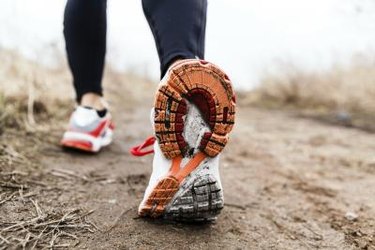
Given the pounding your feet take while running, it's not surprising that you will have some pain occasionally during or after a run. When that pain is focused more on the inside part of the foot, it might be the result of shoes that aren't fitted properly or a flaw in your stride or the actual structure of your feet. Flat feet in particular can stress the inside of the feet when running.
Flat Feet
Video of the Day
The clinical term for flat feet is pes planus and it can be the result of arches that collapse or arches that never developed properly. When someone with flat feet runs or walks, their feet flatten or pronate and turn inward. The result is added stress to the structure of the inner foot, and in particular the faschia, the tissue that runs from the heel across the arch to the ball of your foot. To overcome low arches or flat feet, roll your feet toward the outside as you run. But the more comprehensive solution may be to look for better arch support in your shoes, either with orthotics or with running shoes that are designed with firm arch support.
Video of the Day
Tendon Inflammation
Pain along the inside of the foot cans stem from inflammation of a tendon called the posterior tibialis, which helps support the arch of the foot. If you have low arches, extra stress could be placed on that tendon, causing it to be inflamed and painful. Icing your foot three times a day might help bring down the inflammation. Strengthening the muscles and tendons in your foot might also help. Try strengthening exercises like putting on a light ankle weight and pointing your toes inward, outward and upward 10 times each.
Stress Fracture
The pain on the inside of your foot might have nothing to do with the structure of your foot or the inflammation of a muscle or tendon. You might have injured your foot and the continued running has caused a stress fracture. The tarsal navicular bone is especially vulnerable. Wearing a nonweight-bearing cast and taking a break from running is often enough to help the injury heal, though surgery might be required if a more conservative treatment plan does not do the trick.
Prevention
Having a knowledgeable runner or coach evaluate your running form and your stride may be especially helpful if a flaw in your running style can be identified. Changing the way you roll your foot from heel to toe can often be adjusted, or even how your foot strikes the ground can decrease the stress on the inside of your foot. The wear on your running shoes can also offer clues. If more wear is on the inner part of the shoe, you should investigate whether your stride can be altered and whether different shoes can provide the support and flexibility for a healthier step.